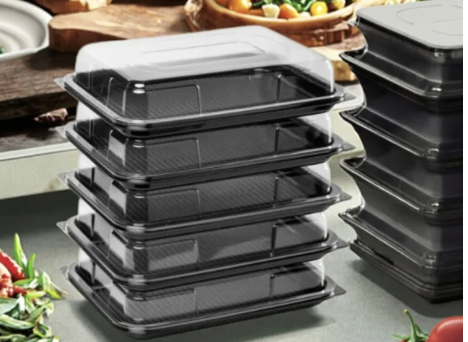Understanding Food Freshness in Modern Storage Solutions
The quest for keeping meals fresh and appetizing throughout the day has led many to rely on plastic lunch boxes as their go-to storage solution. These convenient containers have evolved significantly from the simple boxes of decades past, incorporating innovative designs and materials that promise to maintain food quality for extended periods. The relationship between plastic lunch boxes and food freshness involves multiple factors, from material composition to usage practices, all of which play crucial roles in preserving your meals.
Modern plastic lunch boxes offer various features designed specifically for food preservation. Understanding how these containers work to maintain freshness can help you make the most of your packed meals and ensure they remain safe and appetizing until you're ready to eat.
The Science Behind Food Storage and Preservation
Material Properties and Food Safety
Plastic lunch boxes are manufactured using different types of food-grade materials, each with specific properties that affect food preservation. High-quality plastic containers are designed with materials that resist bacterial growth and prevent chemical leaching. The most common food-safe plastics include polypropylene (PP) and polyethylene terephthalate (PET), which offer excellent barrier properties against moisture and air.
These materials undergo rigorous testing to ensure they meet food safety standards and can maintain their integrity across various temperature ranges. The molecular structure of food-grade plastics helps create an effective barrier that protects food from external contaminants while maintaining optimal internal conditions.
Temperature Control and Insulation
The effectiveness of plastic lunch boxes in maintaining food freshness largely depends on their insulation capabilities. While basic plastic containers offer minimal temperature regulation, advanced designs incorporate multiple layers and air pockets that provide better insulation. Some plastic lunch boxes feature double-wall construction or specialized cooling compartments that help maintain desired temperatures for longer periods.
Understanding how temperature affects food quality is essential when using plastic lunch boxes. Even the best containers require proper initial food temperature and may benefit from additional cooling elements like ice packs for optimal performance.
Design Features That Enhance Food Preservation
Airtight Sealing Systems
Modern plastic lunch boxes incorporate sophisticated sealing mechanisms that create an airtight environment. These seals play a crucial role in preventing air exchange, which can lead to food spoilage and loss of freshness. High-quality containers feature rubber or silicone gaskets that ensure a complete seal, effectively locking in freshness and preventing leaks.
The effectiveness of these sealing systems depends on proper maintenance and careful handling. Regular inspection and cleaning of sealing components help maintain their functionality and ensure consistent performance in preserving food freshness.
Compartmentalization and Organization
Strategic compartmentalization in plastic lunch boxes serves multiple purposes in food preservation. Separate compartments prevent different foods from mixing and affecting each other's freshness and flavor. This design feature is particularly important when packing various food types with different moisture content or temperature requirements.
Advanced container designs include adjustable or removable dividers that allow for customized organization based on specific meal requirements. This flexibility helps maintain optimal conditions for different food items within the same container.
Maximizing Food Freshness Through Proper Usage
Preparation and Packing Techniques
The way food is prepared and packed significantly impacts its freshness throughout the day. Proper cooling of hot foods before packing, strategic layering of ingredients, and appropriate portion sizing all contribute to maintaining food quality. Using plastic lunch boxes effectively requires understanding how different foods interact and implementing best practices for food preparation.
Creating moisture barriers between wet and dry ingredients, properly sealing containers, and allowing appropriate headspace for certain foods are essential techniques that enhance the preservation capabilities of plastic lunch boxes.
Maintenance and Storage Practices
Regular maintenance of plastic lunch boxes ensures their continued effectiveness in preserving food freshness. Proper cleaning, drying, and storage between uses prevent bacterial growth and maintain the integrity of sealing mechanisms. Understanding how to care for different types of plastic containers helps extend their useful life and preserve their food preservation properties.
Implementing proper storage practices, such as keeping containers in a cool, dry place and avoiding exposure to extreme temperatures, helps maintain the structural integrity of plastic lunch boxes and their ability to keep food fresh.

Common Questions About Food Storage
How Long Can Food Stay Fresh in Plastic Lunch Boxes?
The duration food remains fresh in plastic lunch boxes depends on various factors, including the initial food temperature, storage conditions, and container quality. Generally, properly packed food can maintain its freshness for 4-6 hours when stored at appropriate temperatures and using high-quality containers with effective sealing systems.
Are All Plastic Lunch Boxes Food Safe?
Not all plastic containers are suitable for food storage. Look for containers specifically labeled as food-safe and BPA-free. These containers undergo testing to ensure they don't release harmful chemicals and maintain food safety standards across various temperature ranges.
What Foods Should Not Be Stored in Plastic Lunch Boxes?
While plastic lunch boxes are versatile, certain foods may require special consideration. Highly acidic foods, extremely hot items, or foods that release strong oils may affect container integrity or require specific storage conditions. Understanding these limitations helps in making appropriate choices for food storage and maintaining container quality.
How Can I Extend the Freshness of Packed Meals?
Implementing proper packing techniques, using appropriate cooling elements, and maintaining optimal storage conditions can significantly extend meal freshness. Regular container maintenance, proper food preparation, and understanding storage requirements for different food types all contribute to maximizing the effectiveness of plastic lunch boxes in preserving food quality.

